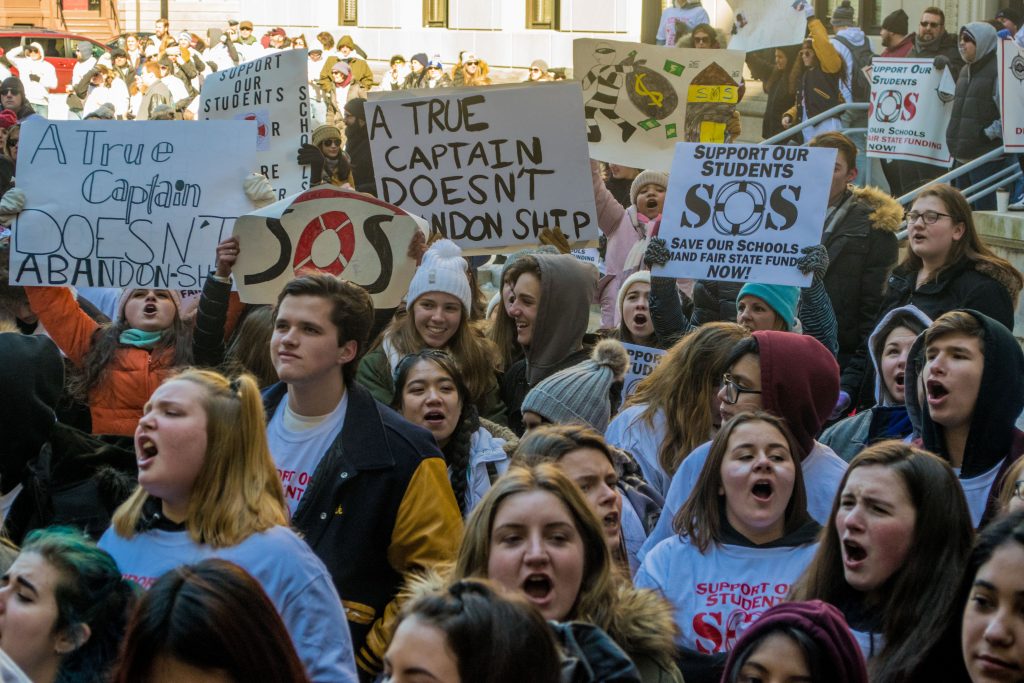
Toms River, Brick and students from 70 other districts across New Jersey attend a rally in Trenton over school funding cuts, March 5, 2019. (Photo: Daniel Nee)
Toms River Regional school officials on Wednesday night said more than 60 district staff members could be laid off as a consequence of the state’s revised funding formula, which slashes the school system’s budget by $18 million over the next five years.
After eliminating 77 positions before the start of the 2019-20 school year, the district may be forced to shed another 62 employees, including teachers, before next school year. A reduction in staffing was one of four options – none positive, officials say – that may be available to the regional school district to make up for a cut of $4.3 million in state funding next school year. The $18 million in cuts is being phased in over a seven year period, at which point it will become permanent.
“The bottom line is that there’s an injustice going on in our community,” said Superintendent David Healy. “Depending on whether or not the governor signs the bill to let our district exceed the 2 percent cap … our district may be able to stay intact for one more year, but this would come at an enormous expense to our taxpayers.”
The bill Healy referenced would allow school districts which had their funding cut by Trenton to raise property taxes above the state’s 2 percent cap. The bill is being “fast tracked” at the statehouse, according to a Brick school district official who is dealing with the same cuts under S-2, a bill engineered by state Senate President Steve Sweeney (D-Gloucester) and signed into law by Gov. Phil Murphy that eliminated funding known as “adjustment aid” for several districts across the state. Under the state’s formula, which the state itself has refused to release, finds that property taxes are too low by its calculations and redistributes funding elsewhere.
The second of four options would be to take full advantage of a measure to raise taxes above the cap. Business Administrator William Doering said taxes would rise by $146 per year above the cap for Toms River residents who own an average-priced home. But the tax increase would cover just one school year, and would also have to fund contracted raises for unionized staff members whose contracts have already been negotiated. Doering said the district can not use the cuts as a negotiating tool in future contract talks because it may be considered an unfair labor practice. Tax hikes would continue, likely on a larger scale, in the years to come, officials said.
A third option would be the elimination of all sports and co-curricular activities. But even such a drastic move would leave a $500,000 budget hole remaining, necessitating at least a small number of layoffs. The option to end all sports and activities would likely prove unpopular with students and parents, and township officials have raised concerns over the social growth of students if they do not have activities after school.
“We have concerns over what children will be doing in that time period, and so does our police chief,” said Healy, adding that 13,000 students participate in at least one co-curricular activity.
The remaining layoffs could hit any department, from teachers to maintenance workers. Already, the district is facing pressure to keep up its hundreds of acres of land, according to officials.
“Our Building and Grounds department is running on a skeleton crew already,” Healy said.
The final option to avoid the worst tax increases would be to implement a “pay to play” system for sports and activities. But it would be expensive, Doering warned.
“If you have a family with two kids who participate in three activities each, it will end up being over $1,000,” he said.
Different sports and activities would come with different costs depending on how much it costs to run a particular program, factoring in salaries, frequency of games or meetings and ancillary costs like league fees.
The message to residents: unless there is a major change in Trenton, either the school district will be decimated or homeowners will face costly property tax increases.
As it current stands, staff reductions are the least palatable option.
“As I’ve said before, that is the last thing we do because it increases class sizes and increases our student-to-staff ratio,” said Healy.
Tax hikes above the cap, should a law allowing the practice to pass, are also an option the board may be unwilling to take given the secretive nature of the state’s funding formula.
“Before going to the taxpayers, the known material flaws in the state aid formula need to be fixed,” said Doering, and the formula must be made public. “Only then can the district know its true financial needs for local support. The state wants Toms River Regional to pay as if we have higher per-pupil costs than we do.”
This month, students and staff staged a protest in Trenton to oppose the funding cuts, and the district is continuing to pursue litigation – both to overturn S-2 and make the formula a public document. The lawsuit was recently dismissed by an administrative law judge and the state education commissioner, and will now move into the Superior Court Appellate Division.
“Eventually, in a few years, we will not be able to operate as a school district without Trenton operating a fair and equitable school [funding] formula,” Healy said.


Environment & Weather
Toms River to Receive 561,000 Cubic Yards of Sand in $73.5M Beach Replenishment Project

Police, Fire & Courts
Toms River Kidnapping, Sex Assault Suspect to Remain in Jail








